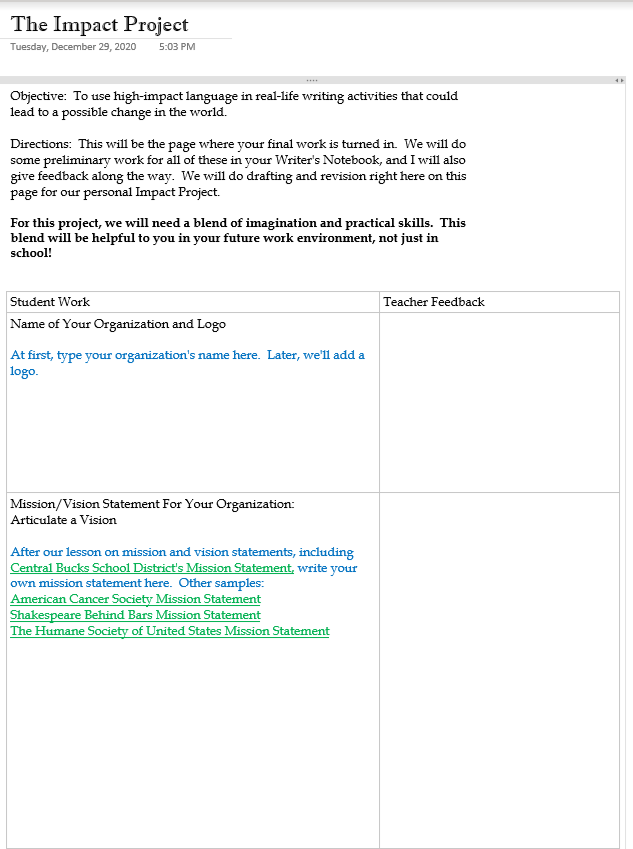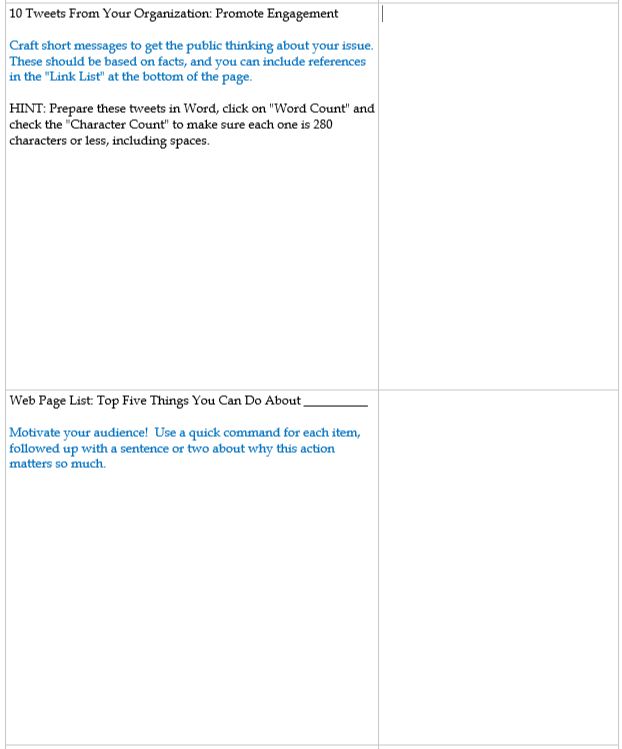
Teaching grammar is my instructional nemesis.
I’m sure I am not alone in feeling this way. For nearly twenty years now, I have worked at teaching grammar in the context of writing, without skill-and-drill worksheets, and every year I tweak my approach, often some variation of Harry Noden’s creative Image Grammar approach. But it’s still the part of the year that humbles me and makes me cognizant of just how much more I have to grow as a teacher.
This year, battling the pandemic and teaching a hybrid schedule for the first time in my life, there are many days that humble me like this. And some that just flatten me. So as I realized the grammar part of my curriculum could be put off no longer, I felt a little queasy. Much of what I have developed through the years to help empower writers with new grammatical structures necessitates small groups, movement around the classroom, or writing conferences alongside a student. For now, these foundational structures are a struggle.
And none of this takes away from two central — and sometimes conflicting — needs.
- To acquire a new grammar skill, students need repeated practice and multiple mentors. Lengthy worksheets, like the ones I experienced as a student, provide this, but entirely out of context for a writer. Valuing and using grammatical skills is unlikely with worksheets.
- To value a new grammar skill, students need to use it writing they care about and notice how it improves their writing. Learning to use a participial phrase once in an essay, however, will not make the learning stick. Transfer is unlikely with slim practice.
To try and meet both of these needs, I had to bring in a third element.
I listened recently to an episode of the podcast Conceptually Speaking, hosted by Julie Stern and Trevor Aleo. Angela Stockman was the guest.
One of the main points in Stockman’s interview was that sometimes we fail to prepare students for the real-world, practical writing challenges they will face when they want to make an impact. Do we teach students how to craft messages for a website or social media? Do we model how to share their thinking in online spaces where they can have an impact?
This seed idea grew into “The Impact Project.” This year, my students started studying grammar by dreaming up a non-profit organization that could have an impact on the world. I asked, “What would be your ideal organization to start so that you can change the world?” This gave us a fresh, unusual context for applying new grammar skills as
I prepared a OneNote page with a simple, two column chart.
At the top of their chart, students named their organization. I shared a few possible ideas just to demonstrate: The Squirrel Appreciation Society (helping humans value the wonderful qualities of squirrels) The Surf and Slope Fund (funding introductions to these two expensive sports for low-income students) and Students’ Rights Now! (a defender of civil liberties within school settings)
On one side of the chart I had a list of steps a student could take to explain, promote, and illuminate their cause. Many of these steps involved creating content for social medial and web publication. In the second column was space for me to leave comments, feedback, and questions along the way. Teaching and learning about grammar became became cyclical and practical.
Write a mission statement for your organization. Write ten tweets to promote interest. Write a brief blog post: “Five Things You Can Do About _____________ Right Now.” Create a Go Fund Me page. Craft and Instagram Post.
Here are some screen-shots to help you picture what I’m talking about.


As I introduced new concepts from introductory dependent clauses to colons to hyphenation, we had a place to immediately practice the skills in writing, framed with a topic that already fascinated students and relevant, real-world structures. Lessons included a line like this: “So now that we’ve learned a little about dependent clauses, let’s try using them in some tweets on your Impact Project page in OneNote”
By the end of the unit, there was plenty of “copy” available for students to choose their best work to share for summative assessment. They could choose their most exemplary applications of the skills and be assessed on them. All I had to do was give them one more page and the opportunity to pull and highlight their best examples from throughout the project.
I learned several things through this approach that I hope to keep with me.
- Inviting students to dream something into existence helps me get to know my students and their values. In a year where there are literal and physical chasms of distance between us, I learned that some of my students are concerned with drawing attention to the plight of Uyghur Muslims in China, supporting families after a miscarriage, and paying college athletes. Their appeals to save honeybees, polar bears, and small businesses gave me a glimpse of what passionate, caring people they are in a year that features fewer face-to-face side conversations in the classroom.
- Practice does not have to involve worksheets. As my students crafted ten tweets, I kept adding new linguistic structures to play with and work into their writing. This gave them a chance to practice more than they needed for assessment. So rather than practicing on worksheets and then answering test questions, or seeing something once, applying it in writing so a teacher can see they did it and moving on, students had the chance to practice each skill multiple times.
- A spoonful of sugar makes the grammar go down. Because this project involved designing a logo, creating “copy” that is just like professional writers create, and looking at mentor texts from other non-profit organizations, it tapped into an element of fun that can be tricky to find when working with grammar skills.
- Low-key research is the best. Though we did not create a bibliography, I did have students keep a list of links they used for any facts and stats. These lists turned out to be impressive in length and quality. Research was not the focus here, but it happened nonetheless, without students being told to, and in the future, I could see finishing this all up with an annotated bibliography.
Overall, this was a silver lining to start the year. It’s also a project that can expand or contract as needed in the future. The framework could be used to study four skills or twenty, depending on the time available. Students can just keep going back and tweaking the copy they have created using fresh skills each time.
Along the way, students had the chance to confer in online breakout rooms and share their passions with classmates. They had the option of turning their work into a web page or online newsletter on Sway to share with the world beyond the classroom.
Next marking period, we will create a promotional poster to promote these causes. And while it hasn’t happened yet, I can’t help but think that maybe one of these organizations they dreamed up may come into existence one day with my student at the helm. Several students already started to take these causes to the real world on their own social media. I know they will use their ninth grade grammar to make it happen.
Now for an afterword, and a little aside to my readers . . .
Although my focus for this year on this blog has been the instructional discoveries I am making and silver linings I am finding through difficult times, it would be disingenuous to ignore the word “difficult” in that sentence. No matter what our focus, there are days hard for everyone, and I often leave a day of teaching exhausted, discouraged and frustrated. I feel those things more this year than ever in my career. The notion of a silver lining still suggests a dark cloud.
Nevertheless, we carry on. Still, I find these new paths and moments of insight. Teaching does not stop teaching us. Maybe you feel the same.
I hear you. I see you. And you are making a difference, no matter the circumstances you find yourself in today. Take care of yourself. Keep dreaming up new instructional strategies to try, and enjoy the process of watching what happens.
— Brett Vogelsinger
What is your instructional nemesis? How are you working through it in the curriculum during this most trialsome school year? You can connect with me on Twitter @theVogelman or engage on Facebook at facebook.com/movingwriters to continue the conversation.
At Moving Writers, we love sharing our materials with you, and we work hard to ensure we are posting high-quality work that is both innovative and practical. Please help us continue to make this possible by refraining from selling our intellectual property or presenting it as your own. Thanks!
